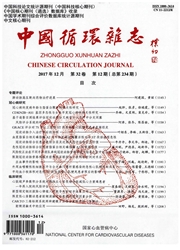

 中文摘要:
中文摘要:
目的:探讨凝集素样氧化低密度脂蛋白受体-1(LOX-1)甲基化在同型半胱氨酸(Hcy)对动脉粥样硬化过程中降低内皮细胞存活率的作用机制研究。方法:按不同浓度的Hcy对人脐静脉内皮细胞作用分组:对照组(0μM Hcy)、50μM Hey组、100μM Hcy组、200μM Hcy组和500μM Hcy组;②100μM Hey+30μM维生素B12+30μM叶酸组(拮抗剂组),各组(n=5)培养液孵育72h后,采用3-(4,5)-双甲基-2-噻唑-(2,5)-2苯基溴化四氮唑蓝试验检测Hcy对内皮细胞活性的影响;用分光光度比色法检测各组细胞中过氧化氢;酶免法检测氧化低密度脂蛋白、甲基转移酶-1(DNMT-1焓量;荧光定量聚合酶链式反应(PCR)测LOX-1和DNMT-1mRNA的表达;蛋白免疫印迹法测LOX—l蛋白的表达;巢式降落式PCR法测LOX-1基因甲基化的改变。结果:同型半胱氨酸对人脐静脉内皮细胞存活率的影响:拮抗剂组与对照组比较差异无统计学意义(P〉0.05)。100、200、500μMHcy组与对照组比较:氧化低密度脂蛋白和过氧化氢的含量、LOX-1信使核糖核酸(mRNA)相对甘油醛-3-磷酸脱氢酶(GAPDH)表达量及LOX-1蛋白相对B-肌动蛋白表达量均增加;DNMT-1的含量和mRNA表达、LOX-1基因甲基化程度均降低,差异均有统计学意义(P〈0.001)。结论:LOX-1低甲基化可能是Hey致内皮细胞损伤的重要机制之-,其中过氧化氢、氧化低密度脂蛋白和DNMT-1可能起了重要的作用。
 英文摘要:
英文摘要:
To investigate the Leetin-like low density lipoprotein receptor-1 (LOX-1) methylation mechanism in damaged human umbilical vein endothelial cells (HUVECs) induced by homocysteine (Hcy). Methods: Primary cultured HUVECs were treated with Hcy as ① Control group (Hcy 0 μ M) and Hcy at different concentrations of 50, 100, 200, 500 p,M respectively, and ② Antagonist group, HUVECs were treated with Hcy 100μM + vitamin B12 30μM +folic acid 30 μM. All cells were incubated for 72 hours. The effect of Hcy on HUVECs activity was measured by MTr method, the cellular H2O2 content was examined by chromatometry, oxidized low density lipoprotein (ox-LDL) and DNA methyltransferasel (DNMT-1) levels were detected by ELISA, the mRNA expressions of LOX-1 and DNMT-1 were tested by fluorescent quantitative PCR, and the protein expression of LOX-1 was inspected by Western blot analysis, LOX-1 methylation was reviewed by nested methylation PCR. Results: The effect of Hey on HUVECs survival rate was similar between Control group and Antagonist group,P〉0.05. Compared with Control group, Hcy 100, 200 and 500μM groups showed increased ox-LDL and H2O2 levels, increased mRNA and protein expressions of LOX-1; while decreased DNMT-1 level and mRNA expression, decreased methylation level of LOX-1, all P〈0.001. Conclusion: The hypo-methylation of LOX-1 might be one of the important mechanisms in damaged HUVECs induced by Hcy, in which ox-LDL, H2O2 and DNMT-1 could play the important roles.
 同期刊论文项目
同期刊论文项目
 同项目期刊论文
同项目期刊论文
 Homocysteine-Mediated Cholesterol Efflux via ABCA1 and ACAT1 DNA Methylation in THP-1 Monocyte-deriv
Homocysteine-Mediated Cholesterol Efflux via ABCA1 and ACAT1 DNA Methylation in THP-1 Monocyte-deriv Hyperhomocysteinemia induces Cardiac Injury by up-regulation of p53-dependent Noxa and Bax Expressio
Hyperhomocysteinemia induces Cardiac Injury by up-regulation of p53-dependent Noxa and Bax Expressio 期刊信息
期刊信息
